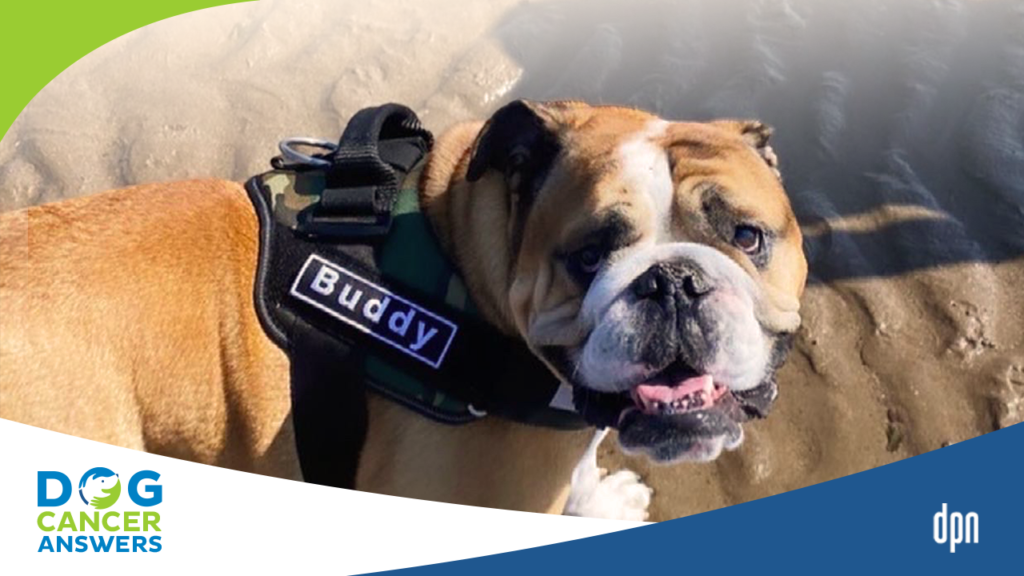Hemangiosarcoma is a frightening and devastating cancer of the blood vessels. Even so, if you can get through the initial crisis, there are treatment options available that can give you more time with your dog and improve her life quality.
Key Takeaways
- The signs of hemangiosarcoma in dogs are related to blood loss. They are either vague (like not wanting to eat once in a while, or being lethargic one day and normal the next) or acute, serious, and scary.
- An internal bleed from a hemangiosarcoma tumor can cause weakness, extreme lethargy, pale lips and gums, rapid breathing, labored breathing, sudden abdominal swelling, lack of appetite, nosebleeds, and even depression.
- In early stages, dogs don’t show signs of pain. Even with large, life-threatening tumors, they may show absolutely no signs that anything hurts unless they are in crisis with a tumor rupture.
- The end stages of hemangiosarcoma are usually related to blood loss, in which case you will see signs of shock and weakness or complications from metastasis.
- Without treatment, dogs have days to weeks to live with visceral or heart hemangiosarcoma. Surgery lengthens that time by months, and chemotherapy can lengthen it even longer.
- The prognosis is much better for skin hemangiosarcoma, with a stage 1 tumor having a median survival time of about 26 months. (That means that half the dogs with this diagnosis will still be alive at 26 months.)
- The median age dogs are diagnosed with hemangiosarcoma is ten years of age.
- At this time, there are no simple blood tests or other inexpensive tests that would catch this cancer early.
Hemangiosarcoma, the Bloody Dog Cancer
Hemangiosarcoma, often abbreviated HSA or hemangio, are tumors thought to arise from vascular endothelial cells. These cells line the arteries, veins, and capillaries, so hemangiosarcoma in dogs can occur anywhere there are blood vessels.
We say “thought to arise” in these cells because some data suggest a pluripotent bone marrow progenitor cell (a type of stem cell) as the cell of origin.1,2
Whatever the original cell involved, there are several possible locations where you might see hemangiosarcoma in dogs.
- The most common locations for primary hemangiosarcoma include the spleen, the right atrium of the heart, the liver, and subcutaneous (under the skin) tissues.
- The most common locations for metastasis are the lungs and liver.3
Regardless of where they occur, these tumors are fragile and full of blood, rupturing easily and often causing significant internal bleeding.
The First Symptom of Hemangiosarcoma
The first symptom of hemangiosarcoma is frightening and potentially life-threatening: a tumor ruptures and the dog begins showing symptoms of blood loss.
Symptoms like pale gums, labored breathing, collapse, and others mean an emergency veterinary visit is needed.
Stats and Facts about Hemangiosarcoma
While every case is different, some known facts exist about hemangiosarcoma in dogs.
- Hemangiosarcoma is most common in middle-aged and older dogs, with the median age at diagnosis being ten years.1
- Hemangiosarcoma accounts for about 5% of cancer cases in dogs4
- Hemangiosarcoma accounts for 5% of all visceral neoplasms3 (organ cancers) and about 50% of splenic malignancies (spleen cancers) in dogs.15
- Hemangiosarcoma is the most common heart cancer, accounting for 40% of all heart cancers in dogs.5
What Causes Hemangiosarcoma?
Like many cancers, the cause of hemangiosarcoma is unknown, and there is no one cause.
(All cancer types are “multifactorial,” which means they have more than one cause.)
There is likely a genetic component for hemangiosarcoma since it is seen more commonly in certain purebred dogs.3
hemangiosarcoma in dogs, what are end stages of hemangiosarcoma in dogs, stage 1 hemangiosarcoma in dogs, symptoms of hemangiosarcoma in dogs, hemangiosarcoma in dogs treatment Boxers are statistically more prone to hemangiosarcoma.
Risk Factors for Developing Hemangiosarcoma
Hemangiosarcoma is most common in purebred Golden Retrievers, Boxers, German Shepherd Dogs, and Labrador Retrievers.5,6
Other risk factors include:
- Sterilization (especially in females) increases the risk of splenic hemangiosarcoma6
- Sun exposure (UV light) increases the risk of skin hemangiosarcoma5
Signs and Symptoms of Hemangiosarcoma
The signs and symptoms of hemangiosarcoma depend on the disease’s location and stage.
There may be no noticeable symptoms in the early stages of hemangiosarcoma, which is one reason we don’t often catch this cancer early.
There may be no noticeable symptoms in the early stages of hemangiosarcoma, which is one reason we don’t often catch this cancer early.
Vague, Intermittent Symptoms
Because these tumors are in the walls of blood vessels, they may bleed intermittently, causing vague symptoms that come and go for no obvious reason, like lethargy and not wanting to eat.
Hemangiosarcoma Tumor Ruptures
When a tumor ruptures, the symptoms become more frightening due to acute blood loss.
These symptoms are usually severe and may include:
- Extreme lethargy and weakness
- Panting or difficulty breathing
- Pale gums (white or gray in color)
- Sudden collapse
- Sudden death
Skin Hemangiosarcoma Symptoms
Symptoms of skin hemangiosarcoma are different from that of internal hemangiosarcoma. These tumors are smooth or wart-like raised bumps that are red to purple in color. They are most often found in areas with sparse hair, such as the tummy on the abdomen.
Diagnosing Hemangiosarcoma in Dogs
When the dog first arrives at the veterinary hospital, the symptoms of hemangiosarcoma are usually either vague and nonspecific or acutely severe with signs of hypovolemic shock (blood loss).
Diagnosing hemangiosarcoma is often presumptive, meaning your veterinarian will diagnose based on what they see in the appointment with minimal or no pathology testing.
They can assume a hemangiosarcoma diagnosis because certain things signal hemangiosarcoma:
- Signalment (age, breed, and gender)
- Symptoms (see below)
- The presence of masses (typically on the spleen) that may be seen during preliminary imaging of the abdomen and its organs (x-rays and/or ultrasound).
Physical Exam
During the initial physical exam, your veterinarian will look for signs of blood loss (such as pale gums and changes in heart rate), difficulty breathing, muffled heart/lung sounds, abdominal pain, a mass they can feel with their hands (palpate), and/or abdominal fluid.
Blood Work
Blood work is often performed to look for abnormalities, especially those associated with blood loss: anemia, internal organ function, and electrolyte imbalances.
Imaging
Diagnostic imaging will also be recommended to find out where the tumor is.
Radiographs (x-rays) can help identify if the spleen is enlarged or if there are masses in the abdomen. X-rays can also identify if metastases are present in the lungs or if the heart is enlarged.
An ultrasound of the abdomen will help identify masses in specific organs and how much if any, fluid is present in the abdomen.
An echocardiogram (ultrasound of the heart) can identify if there is a mass on the heart and/or pericardial effusion (fluid gathering within the sac around the heart).
Fine Needle Aspirates Are Usually Not Used to Diagnose Hemangiosarcoma
A fine needle aspirate is generally NOT recommended if hemangiosarcoma is suspected because of the risk of bleeding, even from the very tiny, fine needle used.
Exceptions to this might be made when:
- When a suspicious mass does not appear to have significant cavitations (bubbles in fluid that come and go with changes in pressure).
- If there are more solid components to a cavitated mass on ultrasound.
- In the case of a heart mass where a pericardial aspirate may help differentiate hemangiosarcoma from lymphoma (which has more treatment options available).
Biopsies, If a Tumor Can Safely Be Removed
A definitive diagnosis can be made if the tumor is removed (including removing the entire spleen if the mass is within this organ) and a sample is sent out for histopathological evaluation (biopsy).
Prognosis and Staging for Hemangiosarcoma
Unfortunately, hemangiosarcoma is an aggressive cancer type, with up to 80% of dogs already having metastases at diagnosis.5
Up to 80% of dogs already have metastasis by the time they are diagnosed with hemangiosarcoma.
Micrometastasis (the spread of cancer not visible on imaging or to the naked eye but is nevertheless present) is also thought to occur in many patients at diagnosis.
The prognosis for visceral hemangiosarcoma is correlated to the stage of disease, with staging based on a modified scheme by the World Health Organization:7
- Stage I – the disease is confined to the primary tumor site
- Stage II – the primary tumor has ruptured, or there is a large (5cm or greater) tumor present
- Stage III – distant metastases are present
Staging for Hemangiosarcoma
After a histopathologic diagnosis of hemangiosarcoma by excisional biopsy, staging tests may include:
Staging is important in determining the extent of disease
- Bloodwork (CBC and chemistry panel)
- Abdominal ultrasound
- Echocardiogram
- 3-view thoracic radiographs (X-rays)
- And/or a CT scan, which is better able to identify smaller metastases, but is significantly more expensive than the other options for imaging
Staging is important in determining the extent of disease within the body within the body. In addition to giving us a prognosis, this knowledge is integral in creating an informed treatment plan.
However, hemangiosarcoma is aggressive. If funds are limited, once a diagnosis is made, abbreviated staging can be performed or put on hold so money can be spent on treatments.
Prognosis and Median Survival Times for Hemangiosarcoma
Once visceral (organ) hemangiosarcoma has been identified, the prognosis varies depending on the stage and treatments chosen.
- If no treatment is performed, the median survival time (MST) is truly short: usually days to weeks.
- Surgery to remove the tumor and stop bleeding can lengthen the MST to 1-3 months.
- For visceral hemangiosarcoma, surgery and chemotherapy combined improve the MST to 6-9 months, and perhaps slightly longer if the tumor is still Stage I when identified.5
- Survival in dogs with cardiac hemangiosarcoma is typically shorter (<6 months).
- With skin hemangiosarcoma, the MST is generally longer, depending on the stage of the cancer.
- Stage I cutaneous hemangiosarcoma (confined to the skin) has an MST of 26 months5
- Stage II and III (invasive into the subcutaneous or muscular tissues or metastatic disease) will have shorter survival times.
Want to hear a hemangiosarcoma True Tail filled with hope and fun? Laura's Buddy has way beat his prognosis -- hear the story on this special episode of DOG CANCER ANSWERS.
Treatments for Hemangiosarcoma
As with many cancer treatments in dogs, treatment for hemangiosarcoma is not about getting a “cure” but rather is focused on improving and maintaining the quality of life while hopefully extending the dog’s life beyond what would happen if the cancer wasn’t treated.
Surgery
Surgery is the first line of treatment for all types of hemangiosarcoma and is often performed immediately by ER doctors as a life-saving measure.
Stabilizing Your Dog So They Can Get Surgery
Many patients are very ill at diagnosis and must first be stabilized before undergoing surgery. This may require blood or plasma transfusions or fluid therapy to correct electrolyte imbalances.
For heart hemangiosarcoma, stabilization may also require pericardiocentesis (removing fluid around the heart) to relieve pressure and allow the heart to pump normally.
Visceral Hemangiosarcoma Surgery
For visceral hemangiosarcoma, the general goal of surgery is to remove the tumor, stop the bleeding, and try to prevent future bleeding. This usually requires the complete removal of the spleen. The heart must also be monitored due to arrhythmias during and after spleen removal.
Heart Hemangiosarcoma Surgery
For heart hemangiosarcoma, once the patient is stabilized, there are two surgical options.
A pericardiectomy is a palliative procedure that removes a section of the pericardium, the sac around the heart. This is palliative, meaning it helps, but does not cure, because it does not stop bleeding from the tumor but allows fluid to accumulate in the chest cavity around the lungs where there is more space, rather than just collecting around the heart. This decreases the chance of life-threatening tamponade (constriction and ultimate heart failure due to compression within the pericardial sac from the tumor fluid). A pericardiectomy can buy you time with your dog and help with symptom relief.
Removing the actual tumor on the heart is another option. This is riskier and requires the expertise of an experienced heart surgeon because it is so much more invasive than a pericardiectomy. This surgery requires intensive care after surgery for days; MST with this procedure is approximately 1-4 months.5
Skin Hemangiosarcoma Surgery
There is a much better prognosis for skin hemangiosarcoma when surgery is combined with chemotherapy than for visceral or heart hemangiosarcoma. With wide, clean surgical margins and chemotherapy with doxorubicin, MST is on the order of years for less invasive tumors.5
Chemotherapy for Hemangiosarcoma Can Extend Survival Times
For all types of hemangiosarcoma, survival times are typically extended when surgery is combined with chemotherapy.
Doxorubicin is the most used medication and, to date, the most effective one, though other protocols are sometimes used.
Sometimes doxorubicin is combined with cyclophosphamide and/or vincristine,8 and some doctors combine doxorubicin with intracavitary (within the abdominal cavity) carboplatin or mitoxantrone if there is bleeding from the tumor into the chest or abdomen, or evidence of tumor “seeding” within the chest or abdomen.5
Regardless of protocol, up to five total chemotherapy treatments three weeks apart are usually recommended if doxorubicin is used and the drug is well-tolerated by the dog.
Only five doxorubicin treatments are given because exceeding five doses of doxorubicin, particularly in large-breed dogs, typically increases the risk of heart damage. With more than five treatments, the cumulative effects of this drug on the heart continue even if the drug is stopped. The damage can be irreversible and progress to heart failure.
Metronomic Chemotherapy
Metronomic therapy is another chemotherapy option that involves giving smaller oral doses of chemotherapy more frequently (daily or weekly) over a longer period.
The goal of metronomic therapy is not to kill the tumor directly, but to target the tumor’s blood supply by preventing the growth of new blood vessels to the tumor and inhibiting suppression of the immune system by the tumor.
Results on survival times are mixed,9 with some studies suggesting longer survival times when metronomic therapy is paired with traditional chemotherapy and other studies showing no improvement in survival times.
Metronomic therapy may be better tolerated with fewer side effects than traditional chemotherapy in some dogs. However, the efficacy of metronomic treatment is not considered comparable to traditional chemotherapy when used alone to treat hemangiosarcoma.
Radiation Treatments
Radiation is recommended for skin hemangiosarcoma when surgery cannot achieve wide margins or if dirty margins are seen on histopathology (biopsy).
Radiation is also recommended as palliative care for skin tumors that cannot be surgically resected (removed). It may be particularly effective in stanching bleeding from these tumors.5
One small study also showed that stereotactic radiation reduced the frequency of pericardiocentesis needed in dogs with hemorrhagic (bleeding) right atrial heart masses.10
Immunotherapy
Immunotherapy options for hemangiosarcoma are being studied and showing promise, but information on this is still limited.
Vaccine
Vaccines are being studied, though none are currently commercially available.
Diet for Dogs with Hemangiosarcoma
The most important thing when feeding a dog with hemangiosarcoma is to make sure that her diet is complete and balanced, providing all the nutrients that her body requires and that a dog is eating consistently, particularly if they are undergoing cancer treatment.
Supplements for Hemangiosarcoma
Two supplements have been studied concerning hemangiosarcoma in dogs: turkey tail mushrooms and Yunnan Baiyao.
There are many supplements that may help cancer in general, but turkey tail mushrooms and Yunnan baiyao have been shown to help hemangiosarcoma.
Coriolus versicolor, also known as turkey tail mushroom, has shown promise in improving outcomes for dogs with hemangiosarcoma. The beta-glucans in this mushroom are thought to bind to immune cells, stimulating their activity to kill and remove cancer cells.11,12
These mushrooms also contain prebiotics which provide food for beneficial gut bacteria (probiotics).12 A healthy gut microbiome is associated with better immunity, so feeding your dog’s gut biome may improve immune response.
This mushroom has also been linked to longer survival in dogs with hemangiosarcoma. One study found that high-dose polysaccharopeptide (PSP), derived from C. versicolor, significantly delayed the progression of metastasis13 and increased median survival time. The follow-up study did not show improvements, however.
Dr. Robert Silver talks about specific medicinal mushrooms that may help dogs with cancer, including turkey tail, on this episode of DOG CANCER ANSWERS.
Yunnan Baiyao is another supplement that may benefit dogs with hemangiosarcoma. It is a Chinese herbal medicine used to decrease bleeding and may help support hemangiosarcoma patients after surgery, or as palliative treatment for patients with bleeding metastatic nodules.14
Dr. Nancy Reese talks about ways to try to stop bleeding at home, including with the "red pill" Yunnan baiyao, in this episode of DOG CANCER ANSWERS.
Always consult your veterinarian before adding a supplement to ensure that it is a good fit for your dog and won’t interfere with any of her medications or treatments. Also, only add one supplement at a time so that if your dog reacts to it poorly, you will know exactly which thing she didn’t tolerate.
In most cases, choosing a few supplements targeting your dog’s primary needs is better than throwing too many at her. This will also help to keep costs down.
Integrative Therapies
Acupuncture may help manage the side effects of treatment and improve quality of life. Acupuncture is generally not recommended in areas of active tumor growth, so it should be used with caution in patients with skin hemangiosarcoma.
The End Stages of Hemangiosarcoma in Dogs
Sadly, many dogs with hemangiosarcoma are euthanized due to severe acute blood loss that ER veterinarians cannot repair.
Those dogs who make it through their initial crisis and get treatment can have a good quality of life, depending upon how well they tolerate the chosen treatments.
If your dog gets through their initial crisis, he or she can have a good quality of life with hemangiosarcoma.
However, hemangiosarcoma is an aggressive and relentless foe, and in the end, most hemangiosarcoma patients eventually die of complications associated with blood loss from ruptured primary tumors or metastases. Dogs with end-stage hemangiosarcoma are often weak, with pale gums and signs of shock.
It is reasonable to talk with your veterinarian about palliative or hospice care for your dog at any point in her illness. This is not “giving up” on your dog and can improve his quality of life. Hospice care may extend the time he has with you in his final stage of life.
Prevention Strategies for Hemangiosarcoma
There are no known strategies for preventing visceral or heart hemangiosarcoma.
For dogs with light skin and thin hair coats, limiting exposure to direct sunlight can help to decrease the risk of cutaneous (skin) hemangiosarcoma.
- Kim J-H, Graef A, Dickerson E, Modiano J. Pathobiology of Hemangiosarcoma in dogs: Research advances and future perspectives. Veterinary Sciences. 2015;2(4):388-405. doi:10.3390/vetsci2040388
- Gorden BH, Kim J-H, Sarver AL, et al. Identification of three molecular and functional subtypes in canine hemangiosarcoma through gene expression profiling and progenitor cell characterization. The American Journal of Pathology. 2014;184(4):985-995. doi:10.1016/j.ajpath.2013.12.025
- Lang B. Sudden death due to acute hemoabdomen and hypovolemia from a ruptured splenic hemangiosarcoma in a German shepherd dog. Can Vet J. 2020;61(11):1203-1205.
- Mingus L. Hemangiosarcoma in dogs. Flint Animal Cancer Center. https://www.csuanimalcancercenter.org/2020/02/28/hemangiosarcoma-in-dogs/#:~:text=Hemangiosarcomas%20are%20malignant%20tumors%20derived,body%2C%20hemangiosarcomas%20can%20develop%20anywhere. Published February 28, 2020. Accessed November 10, 2022.
- Dressler D, Ettinger S. In: The Dog Cancer Survival Guide: Full Spectrum Treatments to Optimize Your Dog’s Life Quality and Longevity. Maui, HI: Maui Media, LLC; 2011:337-344.
- Robinson KL, Bryan ME, Atkinson ES, Keeler MR, Hahn AW, Bryan JN. Neutering is associated with developing hemangiosarcoma in dogs in the Veterinary Medical Database: An age and time-period matched case-control study (1964-2003). Can Vet J. 2020;61(5):499-504.
- Batschinski K, Nobre A, Vargas-Mendez E, et al. Canine visceral hemangiosarcoma treated with surgery alone or surgery and doxorubicin: 37 cases (2005-2014). Can Vet J. 2018;59(9):967-972.
- Sharun K. Chemotherapeutic management of Hemangiosarcoma in canines – an update. Cancer Therapy & Oncology International Journal. 2019;14(1). doi:10.19080/ctoij.2019.14.555878
- Arai S, Milley EP, Lichtenberger J, Savidge C, Lawrence J, Côté E. Metastatic cardiac hemangiosarcoma in a 6 year old Wheaten Terrier mix. Veterinary Sciences. 2019;6(3):65. doi:10.3390/vetsci6030065
- Nolan MW, Arkans MM, LaVine D, et al. Pilot study to determine the feasibility of radiation therapy for dogs with right atrial masses and hemorrhagic pericardial effusion. Journal of Veterinary Cardiology. 2017;19(2):132-143. doi:10.1016/j.jvc.2016.12.001
- Medicinal mushrooms (PDQ®)–health professional version. National Cancer Institute. https://www.cancer.gov/about-cancer/treatment/cam/hp/mushrooms-pdq#_7. Accessed November 15, 2022.
- Mirończuk-Chodakowska I, Kujawowicz K, Witkowska AM. Beta-Glucans from Fungi: Biological and Health-Promoting Potential in the COVID-19 Pandemic Era. Nutrients. 2021;13(11):3960. Published 2021 Nov 6. doi:10.3390/nu13113960
- Brown DC, Reetz J. Single agent polysaccharopeptide delays metastases and improves survival in naturally occurring hemangiosarcoma. Evid Based Complement Alternat Med. 2012;2012:384301. doi:10.1155/2012/384301
- Wirth KA, Kow K, Salute ME, Bacon NJ, Milner RJ. In vitro effects of Yunnan Baiyao on canine hemangiosarcoma cell lines. Vet Comp Oncol. 2016;14(3):281-294. doi:10.1111/vco.12100
- Lee M, Park J, Choi H, Lee H, Jeong SM. Presurgical assessment of splenic tumors in dogs: A retrospective study of 57 cases (2012–2017). Journal of Veterinary Science. 2018;19(6):827-834. doi:10.4142/jvs.2018.19.6.827
Topics
Did You Find This Helpful? Share It with Your Pack!
Use the buttons to share what you learned on social media, download a PDF, print this out, or email it to your veterinarian.









